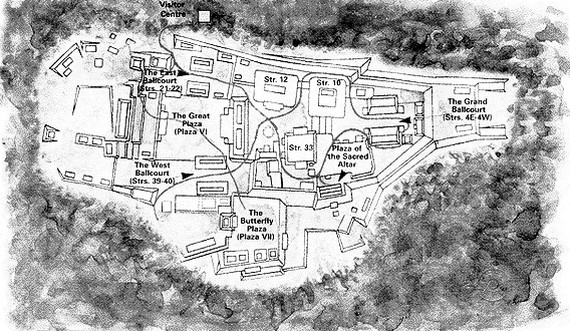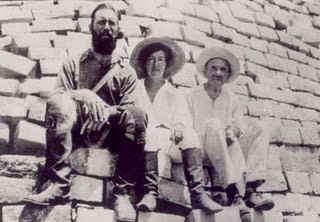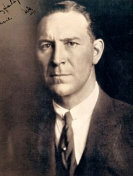

Contact

Home
Hoaxes & Pranks: Monster Hunters
GIANT PYRAMID SECRET.
DISCOVERY IN LOST CITY.
Cairns Post (Qld.)
Date: July 22, 1925
Page Number: 12
Mr. F. A. Mitchell Hedges, the explorer, describes in the following article the discovery in the buried Central American City of Lubaantun of a series of mounds which are believed to cover ancient temples or burial chambers.
Under the axes and machetes of the Indians we have already cleared quite a lot of bush. It is a wonderful sight to see the felling of a primeval jungle and forest. Many of the trees tower between 100 and 200 feet high ; to fell them would appear a Herculean task.
Four or five great trees are chosen by the Indians. They cut into the trunks from both sides with their axes until they are partly through.
Then a veritable giant is attacked so that it will fall and in its downward course crash onto those partly cut.
An ominous crack—the Indians raise a peculiar cry as they run backwards. Crack—crack. Sharp and loud as heavy gunfire. It is going. The tree sways.
Looking upwards against the sky one can see the top slowly moving earthwards, by inches. Then it begins its downward sweep.
ANGRILY BUZZING SWARM.
Full on the partly cut trees it strikes. There is a rumble like thunder, terminating in a roar as they give beneath the weight of the falling monarch. The air is filled with a rushing sound, and as all five strike the ground it trembles as if rocked by a violent earthquake. A blast of air sweeps upward in a whirlwind, carrying clouds of leaves which settle in a shower; and in the impenetrable jungle now a yawning gap appears. For the great trees have carried all before them, crushing flat smaller trees and undergrowth.
With a wisdom born of experience, one keeps well away, for in the big air-plants growing on their trunks are nests of bees and hornets, which rise in thousands in an angrily buzzing swarm.
The branches must be lopped and the trunks "junked" to dry in the burning heat. Finally the whole of the jungle we are clearing will go up in flame and smoke.
Exploring the small amount of clearing we did last year when we first discovered the ruined city and disclosed several stone-faced pyramidal structures, we found that, so rapid is tropical growth in this steaming atmosphere, that although only twelve months have passed, yet they were completely covered again with small trees and bush growing to a height of 10 and 12 feet.
GIGANTIC CITY.
Already our clearing this year has proved we were correct in our surmise that this ancient city is gigantic. Practically from the river for half a mile is a series of mounds, probably beneath which are burial chambers. We shall excavate some shortly to prove this.
These mounds terminate at a low terrace which arises to a courtyard semi-circular in shape, about 75 yards in length by 150 in breadth. Abruptly it ends where, shelving down so steeply that we have had to erect, ladders to climb, is a long, cut stone faced structure in the centre of which are the remains of a stairway. We have not yet been able to do sufficient clearing to give the correct measurements of this.
Exactly in the centre of this structure, and at the top of the ruined stairway, is a clean-cut depression; undoubtedly a constructed road runs due north. We drove a small trail along this for some distance, and on the right-hand side came upon the first great stone pyramid we found last year.
ANOTHER GREAT EDIFICE.
Clearing a section of the bush beyond this we now found that within fifty yards of it was another edifice larger than any pyramid we had previously seen. Cutting the trail further, we came out on the roadwa we had partly cleared last year, but for some time we were unable to find the stone stairway, the farthest point reached when we discovered this city originally.
Ultimately we came upon it, completely grown over-again. This we are now busy clearing.
The immensity of this city is now beyond question; and we know that its size is far greater than even in the first flush of our optimism we believed.
Dr. Gann, who has visited ancient Maya cities of every known period, is definite that architecturally Lubaantun is unlike any previously discovered, and that it will prove of great importance is certain, for undoubtedly here is a mystery, the key to which must lie in the heart of the huge stone pyramids.
F. A. Mitchell-Hedges part 6





A LOST CITY.
Western Mail (Perth, WA)
Date: August 6, 1925
Page Number: 21
The discovery in America of a great aboriginal stone building, covering an area of over seven and a half acres, was announced by Mr. F. S. Mitchell Hedges, the well-known explorer, and Dr. Gann, the archaelogoist, who arrived at Avonmouth (Eng.) after their explorations in the American continent in search of lost cities (states the London "Daily Chronicle").
Mr. Hedges said the building was composed of millions of cut stones. Another of their discoveries was the only ancient stone amphitheatre found on the American continent.
On two sides of the arena were cut stone terraces, while east and west were stone pyramids, which undoubtedly represented "grandstands" from which personages of high rank could look down on what was taking place in the amphitheatre.

THE DEATH OF A NATION.
ONLY 300 MAYAS LEFT.
Chronicle (Adelaide, SA)
Date: August 8, 1925
Page Number: 61
In an article in the London "Daily Mail" Mr. F. A. Mitchell Hedges—the explorer who, with Lady (Richmond) Brown and others, has investigated the little-known interior of British Honduras, Central America—shows how the once mighty and intellectual Maya race has degenerated into a small tribe of hovel-dwelling Indians. Writing from Lubaantua, British Honduras, he says:—
The Maya Kekchi Indians in their village close by, who are working for us, are actually the direct descendants of the people that built the great Maya city we are now busy clearing and excavating. There are but two to three hundred of these Indians left—degenerate and lacking in stamina. They are a remnant of a once high and powerful civilisation numbering probably millions. At their zenith they produced mathematical and astronomical geniuses far in advance of any the world has known to within the last 50 years.
There is a lesson to be read in the small handful remaining, rapidly dying out, for mortality far exceeds birth rate, their scourge being , tuberculosis. From magnificent cut-stone buildings they have, sunk to thatched hovels. From the master mind that originated a calander more perfect even than the Gregorian (which functioned from a date equal to our October 14, 3373 B.C., without the loss of a single day until the Conquest), the majority now have no knowledge of time.
Ancient Habits Remain.
It is incredible to think they come of a race which was once a mighty empire, with its kings, priests, and nobles, stately stone-built cities, temples, and palaces.
In some ways through the thousands of years ancient habits have remained. The women still wear brilliant bead necklaces, carry their children on the hip, and trudge with the heavy burdens. The custom of generations has given them enormous strength in their necks, loads up to two hundred pounds are carried on their backs. They walk in a bent position. A strip of flat, fibrous tree bark passes round the forehead and is tied to the suspended burden behind, the full weight being borne by the head and neck.
In turn each helps the other, to clear tracts of bush for planting their native corn, on which they are dependent for food.
Primitive Justice.
A chief, or Alcalde, with a sub-chief, is regularly appointed. The Indian court sits at night, the two judges and three policemen all dressed exactly like the rest. One dim lantern burns, and in this primitive court they settle all disputes. Our own legal luminaries could learn much from the simplicity and wisdom of some of their decisions. Here is a case in point:—
An Indian's wife had left him and gone to live with another man. Priming himself with drink, her outraged lord went in search of his rival. When they met it came within an ace of murder.
In due course both men were brought before the Indian court. Carefully the judges listened to the evidence. They conferred with one another.
"Send for the woman," said they. She was summoned.
The man she had left for her lover was sentenced to one term of imprisonment in their small wooden gaol. The other, with whom she had gone to live, was given twice the length of sentence.
"And you," said the judges, turning to the woman, "are the cause of all the trouble. That being so, you will go to prison for twice as long as your lover.'

Q'eqchi' (K'ekchi' in the former orthography, or simply Kekchi in many English-language contexts, such as in Belize) are one of the Maya peoples in Guatemala and Belize, whose indigenous language is also called Q'eqchi'.
Before the beginning in the 1520s of the Spanish conquest of Guatemala, Q'eqchi' settlements were concentrated in what are now the departments of Alta Verapaz and Baja Verapaz. Over the course of the succeeding centuries a series of land displacements, resettlements, persecutions and migrations resulted in a wider dispersal of Q'eqchi' communities, into other regions of Guatemala (Izabal, Petén, El Quiché), southern Belize (Toledo District), and smaller numbers in El Salvador, Honduras and southern Mexico (Chiapas, Campeche). While most notably present in northern Alta Verapaz and southern Petén, contemporary Q'eqchi' language-speakers are the most widely spread geographically of all Guatemalan Mayan groups.
Young Q'eqchi' Maya children, Belize

BURIED CITIES OF HONDURAS.
EXPLORERS' FINDS.
Chronicle (Adelaide, SA)
Date: August 8, 1925
Page Number: 13
A cable, message from Jamaica, in June stated Mr. Mitchell-Hedges, the explorer and deep-sea research expert, and Dr. Gann, the archaeologist, had returned from their expedition a year before they had planned to do so. According to the message this was due to the fact that such discoveries had been made in the ruined Maya city in the heart of British Honduras that it was necessary for the explorers to come over in order to confer with the British Museum authorities, who are giving them official support.
"They have discovered the greatest single ancient stone building in the world," stated the cable, "and have uncovered a gigantic ruined city totally unlike any previously discovered. Among other discoveries a gigantic amphitheatre has been cleared and photographed. It is built of solid stone, and is capable of holding 10,000 people. It is the first and only record of such a discovery throughout the whole of the American continent. The health of the party suffered severely, and both Mr. Mitchell-Hedges and Dr. Gann were completely crippled for several weeks. The entire work of organising aud overseeing the gangs of Indians was thus left in the hands of Lady Richmond Brown, who also had the job of nursing both men back to health. Finally Mr. Mitchell-Hedges went down with a severe attack of malaria, and, with his temperature at 105, he was only got back to the coast with great difficulty."
The expedition is reported to be bringing back large quantities of figurines, flint spear-heads, and other objects excavated at the ruins of Lubaantun, direct to the British Museum to be investigated by experts. The trio have also collected some extraordinary and abnormal marine specimens for the Natural History Museum, South Kensington, and for other museums.
Mr. Mitchell-Hedges and Dr. Gann arrived at Avonmouth on June 14. In an interview Mr. Hedges said they had made important discoveries, including what was undoubtedly the greatest aboriginal stone building ever discovered on the American continent. It covered an area of 7.65 acres. The building was composed of millions of cut stones, and when it was realised that the stone must have been quarried and shaped with stone chisels, stone hammers, and stone axes, it was almost inconceivable that men so handicapped could have been able to build such a gigantic edifice.

DEGENERATE YOUNG MEN
Hateful, Pussycat Type
BRAINS IN THEIR FEET
The Mail (Adelaide, SA)
Date: August 29, 1925
Page Number: 3
("THE SUN" CABLE SERVICE) LONDON, Today.
Marie Tempest, the celebrated actress, agrees with Mr. Mitchell Hedges that the modern young man is of a hateful pussycat type, due to the war. He dances all day long and all night long, she says, and his brains have gone to his feet. He does, not know how to love.
No one ever hears nowadays of sensational love affairs, as men have neither the time nor the energy for love.
General Kentish recalls that 63 per cent of the men were physically unfit at the war time. Thousands have not the opportunity of building up their physique by health exercises owing to the lack of open spaces.


Dame Marie Tempest DBE (15 July 1864 – 15 October 1942) was an English singer and actress known as the "queen of her profession".
Tempest became the most famous soprano in late Victorian light opera and Edwardian musical comedies. Later, she became a leading comic actress and toured widely in North America and elsewhere. She was, at times, her own theatre manager during a career spanning 55 years. Tempest was also instrumental in the founding of the actors' union Equity in England.


Brigadier-General Reginald Kentish (1876-1956) was Vice President of the Army Football Association and the British Olympic Council,
honorary secretary of the British Olympic Association, and the founder of the National Playing Fields Association.
A MALE REVIVAL
Urgently Necessary
BRITAIN BECOMING FEMININE.
Advocate (Burnie, Tas.)
Date: September 8, 1925
Page Number: 1
LONDON, Sunday.
Mr. F. A. Mitchell-Hedges, who has lead expeditions and discovered new races in Central America, and who also holds world's records for captures of huge fishes, believes that Britain is "saturated with feminity," and that "a male revival is urgently necessary to enable the country to enjoy prosperity."
The explorer considers "Oxford bags" a sign of degeneracy, and declares that women must realise that men are leaders by the eternal laws of nature.
Mr. Mitchell-Hedges remarks on the disappearance of the pioneering spirit, and says that men are losing their hardiness.


Mitchell-Hedges must be turning in his grave...

EFFEMINATE MEN.
Women's Domination.
The Mail (Adelaide, SA)
Date: August 29, 1925
Page Number: 3
Are the young men of England becoming soft?
Mr. F. A. Mitchell-Hedges, the explorer, thinks they are, and that if the softening continues they will come under the complete domination of women, to the great detriment of State and sex alike (says the London "Daily Chronicle" of August 28).
Mr. Mitchell-Hedges' discoveries and explorations in the buried Maya city in the jungle of British Honduras, to which he was accompanied by Lady (Richmond) Brown, are well known. He is now organising a campaign for a renaissance of British manhood, to prevent domination by the sex which, according to him, is no longer the weaker. This campaign will take the form of propaganda, mainly by speeches, in co-operation with various societies.
"The young men of this country are exhibiting the first symptoms of degeneracy, and the women are seizing the opportunity to become dominant," he said, to a "Daily Chronicle" representative. "The spread of Communism, bad trade, and the growing distrust between the classes synchronises with a serious decline in the virility of the manhood of this country. Take sport, as an example. The prestige Britishers held in nearly all games has departed, but women are rapidly coming to the front in this field. This reversal of the laws of nature has begun not only in sport, but in business, and is spreading to politics and Government offices. Woman revels in her conquests. It is her delight to subjugate and dominate men. She treats them as creatures to obey her whims, and at the same time looks on them with contempt. In a million homes throughout Great Britain to-day the right type of woman, who is married and has grown-up daughters, deplores this fact, which is leading to the disruption of many a home. Fathers find the greatest difficulty in keeping up with the demands of their grown-up daughters.
"While all this dominance by women is causing a serious state of degeneracy among our manhood, it is also undoubtedly resulting in a loss of trade for the reason that we are losing the pioneer spirit which made our great Empire what it is. Every clean-minded healthy man should be an adventurer at heart. If he is a captain of industry and sends out his travellers to open up new markets, he is doing pioneer work. If he has a shop and opens another branch, that is pioneering. If he is a salaried man and changes his position to improve his lot it is the spirit of adventure that makes him do it. The adventurous spirit is what has made Great Britain the power she has been, and to-day that power is on the wane. The history of all great civilisations of the past is an analogy. There woman worship became such an obsession that men degenerated and empires fell as a consequence. It is urgently necessary that in this country there should be a male renaissance. In our public schools the pioneer spirit must be inculcated, pride of race must predominate, and we must realise that by the laws of nature man was fashioned to be leader. A national revival of our man- hood will, I feel certain, do more than any legislation to wipe out unemployment, create better trade, bring back to us the respect of other nations which we are in danger of losing, crush Communism, and restore our ideals."

THE DOMINANT SEX.
The West Australian (Perth, WA)
Date: October 31, 1925
Page Number: 12

One of the latest of our modem Jeremiahs, whose dismal delight it is to proclaim tidings the reverse of joyful, is Mr. Mitchell-Hedges,
the well-known explorer. According to a London contemporary, Mr. Mitchell-Hedges, in a recent jeremiad, is pessimistic concerning
the growing effeminacy of the yonng men of England, while at the same time he deplores the dominating propensities displayed by womankind
in their relations with the other sex. In order that such an anomalous and unsatisfactory state of affairs shall no longer be allowed
to continue, Mr. Mitchell-Hedges is now organising a campaign for a "Renaissance of British Manhood"—a laudable enterprise, which,
if it does nothing else, should at least add to the gaiety and entertainment off the nations. One must confess to being a little weary
of all that is spoken and written about the alleged antagonism of the sexes, and whether woman is conplementary to man, or man complementary
to woman, although one must needs admit that, in the present era of our great and glorious civilisation, neither of them seems disposed
to be particularly complimentary towards the other. It is a truism to say that there is no tyranny quite so intolerable or tyrannical
as the tyranny of the weak over the strong; but if, as Mr. Mitchell-Hedges would have us believe, woman is no longer the weaker vessel,
mankind must automatically, as it were, become innnune from this immemorial source of half his sublunary penalties and pains, and
brace himself up to endure as best he may that almost equally galling tyranny which strength devoted to maleficent ends imposes on
the defenceless weak, unless, of course, the "Renaissance of British manhood" develops into an accomplished fact, in which case we may
reasonably hope to anticipate—what everyone would rejoice to see—a "Renaissance of British Womanhood," something, that is, in the
old style, and a truce to all this wordy controversy on the dreary subject of sex antagonism...
THE PIONEER SPIRIT.
HAS IT DIED?
A STRIKING CHANGE.
Morning Bulletin (Rockhampton, Qld.)
Date: January 22, 1926
Page Number: 3
...
A serious blow to progresion and initiative and a destroyer of thrift is undoubtedly our excessive taxation (declared Mr. A. Mitchell Hedges, the explorer, in the London "Daily Mail"). This is driving many of our finest young, men abroad. They recognise that their chance of success in another country, where taxation is light, enables them to save more money, which can be employed to building up reserves. But the tragedy is that these men are actively competing against the land of their birth and their commercial industry is enriching the foreign country of their adoption.
...


CONTENTS






















